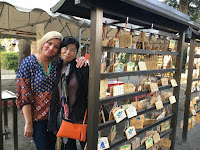Haunting forests, an amusement park deep inside the earth, majestic castles, horse drawn carts, a captivating Count, and houses made of chocolate covered marzipan with scalloped roof shingles straight from the pages of a fairy tale. But don't scatter any bread crumbs to find your way back. Lose yourself in the bewitching land of Transylvania.
Visit the Amusement Park in a Former Salt Mine
Since the times of antiquity salt has been one of the most important commodities on earth. It flavors our food, it has the capability to heal and it has enabled lengthy journeys of exploration due to its preservation properties. At Salina Turda in Cluj County Romania, you can descend four hundred feet into the underground realm of this former salt mine where salt stalactites hang from the ceiling of this cavernous wonderland. Over three billion tons of salt have been excavated from the mine to create an amusement park which is large enough to house several carnival rides and paddle boats. A spin on the Ferris Wheel will leave you enthralled.
Wander Through Corvin Castle
This grand castle, surrounded by a moat, is the setting of a tragic love story. Legend says that King Sigismund was unable to marry Elizabeth, the love of his life, so he married her to his most trusted military advisor, Voyk. After his beloved Elizabeth gave birth to Voyk’s son, the King presented her with a beautiful golden ring. One day, a raven flew by and spotted the shiny ring and stole it away. Thankfully for Elizabeth, her son John Hunyadi was able to track the raven down and retrieve his mothers precious ring. Corvinus is the latin word for raven, which are believed to appear as a sign of prophecy, and as if divined by magic, the King gave this castle to Voyk as a severance in 1409. In 1446 John Hunyadi was elected as regent-governor, and built up this imposing Renaissance-Gothic piece of architecture which is one of the Seven Wonders of Romania.
Go on a Haunted Night Tour of Hoia-Baciu Forest
Strigoi (troubled spirits), who rise from the grave and drain the blood of their victims; the sound of shrieking women coming from deep within contorted trees; a sheperd who is said to have disappeared with his entire flock of sheep; a large, circular patch of land where the Iele nymphs of the forest dance the Hora each night… if these fables intrigue you, then book this private tour! The guide is very knowledgeable and will ignite your imagination. On a clear dark night, when the weather is good, stars, planets and the Milky Way shimmer with incredible clarity in the inky sky. One thing you will experience if you embark upon this tour is exercise! Because if you are the one at the back, you definitely hike faster than you ever have in your life, because you don't want to be left behind!
Stay at the Cottages of the Szekler Count of Transylvania
Along the road to Miklosvar are numerous poles and homes dotted with Stork nests. Storks are legendary for bringing prosperity, and the Szekler Count, Tibor Kàlnoky, is helping Roma children in this small town to escape poverty. Normally these young children would stop attending school around the age of twelve, continuing a cycle of disadvantage and lack of vision for their future. In order to remedy this, Count Kàlnoky has introduced programs to motivate them to stay on at school. One of these programs teaches the children to ride horses if they show a natural talent for doing so. If not, there is a horse grooming program in which the children can come each day to receive a hot meal and are taken to the doctor and dentist when needed. Children who felt that they had few prospects are now entertaining ideas about what they may want to do in the years ahead. Giving these children hope is a happy ending in a fairy tale setting. The Count has also provided many jobs restoring his cottages and transforming his former hunting lodge into the Museum of Transylvanian Life by using local talent and staying true to original design and craftmanship. In these guest houses, you are surrounded by the peacefulness of nature and disconnect from the rush of the world we currently live in. If you book a full board stay you will be taken on tours which differ daily. You will take supper in the main house, and if he's available, dine with the Count himself. The staff are lovely and helpful, and your stay will be nothing less than magical.




















































